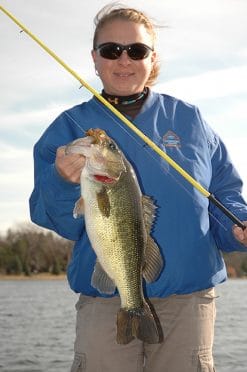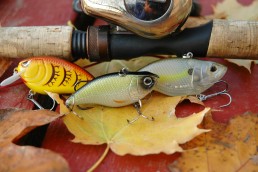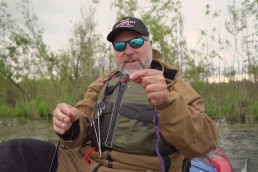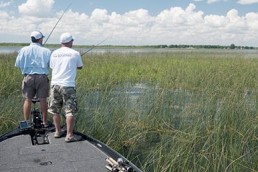Late-season, Last-bite Bass
SHARE THIS POST
If you’re still bass fishing in November in Minnesota, you are a hardcore basser. The rest have given up, turned their attention to deer hunting or are waiting for the upcoming ice season. To all the hardcore bass fishermen out there, I salute you. I will be right out there fishing with you until the ice starts to lock our lakes up.
Grab some warm clothes and a couple of rods. Let’s hop into the boat and see just what the late-season bass bite has in store for us.
To start, fishing open water at this time of the season is not for the faint-hearted; many of the days are cold, so dress accordingly to make it through your day. A good waterfowler suit or ice fishing suit and boots will do you well. Remember this, if you overdress,you can take off some clothing if you get too warm. But on the days you did not dress warm enough, you will be cold all day.
Late-season bass locations
When the bass move shallower with the falling water temps of fall or to intercept the fall frog migration back to the shallows, the late season bite will be in high gear. This is the prime bite of the fall period. As the shallower weeds and pad areas start to die off, the bass will follow food sources out towards deeper water again. When it comes to the late season bass, they start to pile up in certain areas with green weeds. If you do not have green weeds around, chances are pretty good that numbers of bass are not holding in these areas.
Many days, you will have to cover water to get bites. Once you get into key areas, you can slow down and really fish the areas well. Until that happens, keep on moving while looking for bites and signs of bass.
A few areas that hold bass at this time of the season are deeper weed flats and outside deep weed edges. Both of these areas will depend on still having green weeds. Shallower weeds that are a made up of a mix of weeds (dead/alive) will not give off enough oxygen to sustain bass holding in these weeds for long.
Where these fall food sources stop is where the bass will hold for the balance of the fall. It’s a good bet that, later into the season, it will be weedflats and outside weed edges.
Spinnerbaits, vibrating jigs and swim jigs will all be prime baits to cover water when looking for bites. Do not spend a lot of time in one area. The bass will be on the move, looking for their next meal. The key to triggering bites when fishing the flats for bass is to make contact with the very weeds that you are fishing.
If conditions are right, dig out a big topwater bait like a Spook or a Whopper Plopper bait and go to work. This may fast turn out to be the highlight of your late-season bassin’. Seeing big bass come up on a topwater bait late in the season on a sunny, calm day will be a day to remember.
Are you enjoying this post?
You can be among the first to get the latest info on where to go, what to use and how to use it!
Deep diving over flats
As the bass move deeper on the flats, it is time to pull out a Spro Aruku Shad and a Spro Russ Lane Square Bill. These baits have a tendency to call bass from the deeper weeds and flats to come to the bite. You can also rely on slow rolling a bigger, double-willow spinnerbait. The reason for the double willows is a willow blade has the least amount of lift of all the blades out there and you can keep your bait closer to the deeper weeds that you are targeting. When fishing the shallower weeds, the more contact that you can make with the weeds with these baits, the more strikes you will generate.

One key point here, use your line size that you are fishing to help you turn wasted casts into bites. What I am trying to say is, if you fish with 10-pound-test line, the bait can get buried deeper into the weeds, making your chances of getting the bait free and on its way again few and far between. If you limit the depth that the bait can dive to by using a larger line size, you can still make contact with the weeds and break it free to trigger more strikes. Use a bigger line size to your advantage as it will help you put more fall bass over the side of your boat.
The last place to find bass before ice up will be the deep outside weed edges. Once again, look for green weeds as these are key. The top two baits for this tactic will be deeper-diving crankbaits and jigs. The best way this system works is, position your boat a cast away from the weedline. Boat positioning is key for this pattern. If you are positioned too close to the weedline, you will get the crankbait buried into the weeds every time. If you are too far from the weeds, you will lose the trigger of the bite by not contacting the weeds as you work your crankbait back to the boat.
Another point to make here is, certain crankbaits work better than others. The best crankbait to use for this tactic is a crankbait that has a wide wobble instead of a bait that has a tight wobble. The reason for this is, wide-wobble crankbaits will get through the weeds better, shedding the weeds as it comes through them. A tight-wobble crankbait has a tendency to become fouled more often than a wider-wobble crank, turning that cast into a wasted cast.
Make your cast and reel the bait down. Your intention is to contact the weeds. When that happens, act like you are setting the hook to get the bait free and on its way again. This is many times when the strike will happen, so be ready.
When you get into an area that has a few bass, make another pass, slow down and work the area with a jig. The crankbait will take the aggressive bass in the area, but the jig will take the non-aggressive bass in the area. Many times these are the bigger bass in the system.
So, do not be so quick to put your boat away this fall. Take advantage of the last-bite that happens in all Minnesota lakes. Grab a handful of baits, dress warm and hit the water. You will be in store for some of the best bass fishing that this state has to offer. It will be a good bet that you will pretty much have the water all to yourself. Also, do not forget you may just end the season with your biggest bass of the year!
MWO
SHARE THIS POST
Did you enjoy this post?
You can be among the first to get the latest info on where to go, what to use and how to use it!
Scott Petersen
Scott Petersen has been writing for the past 30 years. A Minnesota native, he has a passion to fish all seasons on ice and open water. “One of my main goals is to teach people how to fish through my articles and sport-show seminars.”



